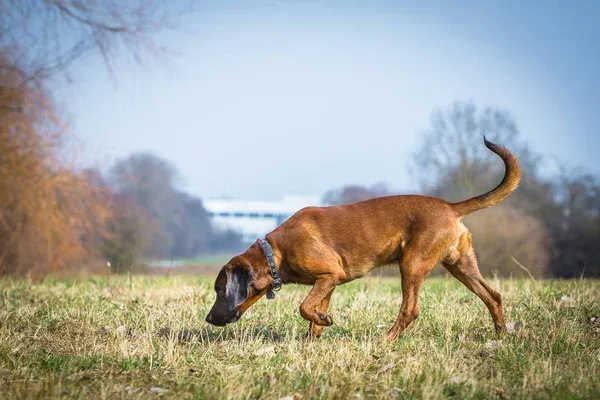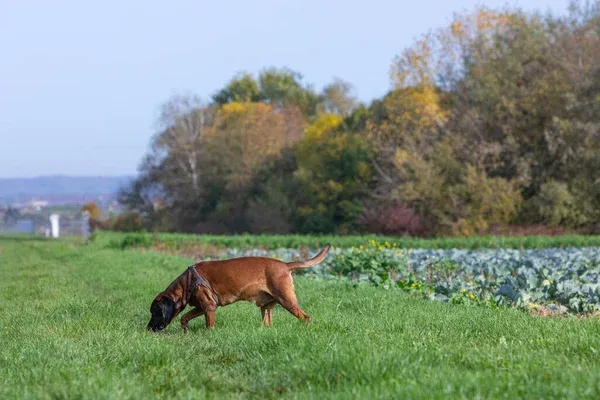Bloodhounds have a long-standing reputation for their outstanding sense of smell, a trait that has made them invaluable in tracking and search-and-rescue operations. Their olfactory abilities are so keen that they're often considered the gold standard for scent-tracking breeds. The question of whether bloodhounds can smell blood is rooted in their history as hunting dogs, where they were used to trail wounded game.

Scientific analysis reveals that the keen nose of a bloodhound is not just a matter of olfactory cell quantity but also the breed's ability to process and identify complex scents. Bloodhounds possess up to 300 million scent receptors, compared to about 5 million in humans, and the area of their brain responsible for analyzing smells is proportionally larger than that of other dogs. This biological specialization allows them to detect not just blood but a wide range of bodily scents at incredibly low concentrations.
Understanding the bloodhound's scent-tracking capabilities involves more than acknowledging their impressive nose; it's also about recognizing their training and behavior. Trained bloodhounds are capable of following a scent trail for miles, even across water and through challenging terrain. This skill is not limited to fresh scents, as they can follow trails that are days old, which is particularly important in search-and-rescue operations or criminal investigations where time is a critical factor.

The Unique Abilities of Bloodhound Scent Detection
Bloodhounds have an unmatched capacity for scent detection, which is attributed to their acute olfactory system and specialized physical structure. The breed's superior scenting ability is highly regarded in various search and tracking operations.
Overview of Scenting Ability
Bloodhounds possess an extraordinary sense of smell, allowing them to pick up and follow scent trails that are days old. Their scenting ability is so refined that they can discern individual scents even in a crowded and complex olfactory environment.
- Specificity: They can distinguish specific scents from a multitude of others.
- Persistence: A bloodhound's scent tracing can continue over long distances and times.
The Science Behind Their Powerful Nose
A bloodhound's nose is lined with a significant number of scent receptors, far surpassing the average dog. With approximately 300 million olfactory cells, their sense of smell is among the strongest in the canine world. The olfactory area in their brain, which processes scents, is also remarkably large relative to other breeds, allowing for detailed scent analysis.
- Scent Receptors: Approximately 300 million in number.
- Olfactory Brain Region: Large and highly developed.
Physical Attributes Contributing to Scent Detection
The physical structure of a bloodhound's nose and face plays a crucial role in their scent detection capabilities. They have long, droopy ears that help to trap scents close to the nose, and loose, wrinkled skin around the face that helps to capture scent particles.
- Ears: Long and pendulous, they sweep odors towards the nose.
- Facial Skin: Wrinkly, helping to trap scent particles near the nostrils.
Bloodhounds are often described as 'noses with dogs attached' because of their exceptional and defining traits their powerful sense of smell. Their abilities make them invaluable assets in search and rescue missions, as well as in tracking down missing persons or escaped prisoners. The breed is uniquely designed for scent work, setting the standard for olfactory capabilities in dogs.
Bloodhound Origins and Characteristics
The bloodhound is revered for its exceptional tracking abilities, tracing its lineage back to historical hunting practices, and is characterized by distinctive physical attributes that meet specific breed standards.
Historical Background
Bloodhounds have a storied past, originating from ancestors known as 'St. Hubert's hounds' around the 8th century in Europe. Primarily, they were bred by monks at the St. Hubert monastery in Belgium, and later refined in England to assist in hunting deer and tracking people. History indicates that they have been employed by law enforcement for centuries, due to their unrivaled scent-tracking capabilities.
Physical Appearance and Breed Standards
According to breed standards, bloodhounds possess a noble and imposing presence, with males standing at a height of 25 to 27 inches and females 23 to 25 inches. They typically weigh between 80 to 110 pounds. Their coat, which can be black and tan, liver and tan, or sometimes red, is composed of short fur that is dense and weather-resistant. The eyes of a bloodhound are deeply set and have a characteristic droop, adding to their contemplative expression. The breed is known for its loose, wrinkled skin and long, drooping ears, which enhance its ability to pick up and retain scent particles.
| Trait | Description |
|---|---|
| Height | Males: 25-27 inches, Females: 23-25 inches |
| Weight | 80-110 pounds |
| Coat Colors | Black and tan, Liver and tan, Red |
| Eye Set | Deep, drooping |
| Skin | Loose, wrinkled |
| Ear Length | Long, drooping |
Bloodhounds are a distinguished dog breed whose history and physical characteristics have been refined over centuries to make them superb tracking dogs.
Working Roles and Training of Bloodhounds
Bloodhounds have an unmatched reputation for their scent tracking abilities, which makes them invaluable in law enforcement and search-and-rescue operations. Their training is rigorous and tailored to harness these innate skills for practical applications.

Employment in Law Enforcement and Search Efforts
Bloodhounds play a pivotal role in law enforcement due to their exceptional sense of smell — advanced enough to differentiate between a vast array of human scents and to follow trails that are days old. Police departments commonly employ these tracking dogs for various tasks such as locating missing persons, fugitives, or evidence related to criminal activity.
Search and rescue missions also benefit from the bloodhound's tracking talent. They can follow a scent trail through challenging terrains and over long distances, which proves crucial in natural disasters, locating lost hikers, or finding victims of avalanches and earthquakes.
Training Requirements and Practices
The training of bloodhounds is a complex, meticulous process that starts from a young age. Handlers emphasize positive reinforcement to mold these hounds into proficient trackers. Below is an outline of the core training practices:
- Basic Obedience: Essential for any police work, it includes sit, stay, heel, and come commands.
- Scent Discrimination: Bloodhounds learn to pick out a specific person's scent from a multitude of others.
- Trail Work: Involves following a scent over varying distances and terrain types to simulate real-life tracking conditions.
Bloodhound training also incorporates a variety of environmental exposures to ensure these dogs can track through diverse conditions, such as urban settings and wilderness. Regular practice and consistency are keys to maintaining their high level of tracking performance.
Bloodhound Health and Care
Bloodhounds are renowned for their tracking ability, but to perform at their best, they require diligent health maintenance and attentive care.
Common Health Concerns
Bloodhounds are prone to certain health problems. Bloat, a rapid, life-threatening stomach condition, is a potential risk, making it crucial to monitor this breed's diet and eating habits. Regular visits to the veterinarian are important to oversee their health, including managing risks of skin infections due to their wrinkles. Their distinctive long, floppy ears can also trap moisture and lead to infections if not cared for properly. Owners should pay special attention to their shoulders, a common site for issues in larger, active dogs.
| Health Concern | Signs to Watch Out For | Preventive Measures |
|---|---|---|
| Bloat | Swollen abdomen, distress | Feed smaller, frequent meals |
| Ear Infections | Redness, odor, discomfort | Regular cleaning and inspection |
| Skin Infections | Inflammation, excessive scratching | Keep skin folds dry |
| Joint Issues | Limping, stiffness | Maintain a healthy weight, regular exercise |
Proper Grooming and Maintenance
Grooming is essential not only for a Bloodhound's appearance but also for its overall well-being. Regular bathing is necessary to keep their skin clean and free from ticks and other parasites; however, their coat does not require excessive grooming. Post-bath, it's crucial to thoroughly dry their deep wrinkles to prevent any infections. Nail care should be consistent to prevent discomfort and mobility issues, while regular teeth brushing will ward off dental problems.
- Ears: Clean weekly to prevent infections.
- Skin: Check and clean folds during bathing.
- Nails: Trim as needed to prevent overgrowth.
- Teeth: Brush several times a week with appropriate canine toothpaste.
The Bloodhound's Social and Behavioral Traits
Bloodhounds are known for their distinctive personality traits and behaviors, particularly their gentle and even-tempered nature that makes them excellent family companions, while their tenacity is evident in their tracking work.
Temperament and Interactions
Bloodhounds are inherently affectionate and gentle, which contributes to their reputation as devoted family dogs. Despite their size, they tend to be loving towards children and can socialize well with other dogs if introduced properly. However, their strong tracking instinct may drive them to follow a scent with little regard for commands, which can be interpreted as stubbornness.
- Personality Traits:
- Gentle: Patient and calm with family members.
- Loving: Shows affection readily, enjoys closeness.
- Social Behaviors:
- Family-oriented: Excellent integration into family settings.
- Interaction with other pets: Can be sociable when trained properly.
Training for Socialization and Obedience
Training a bloodhound requires consistency and patience, with an emphasis on positive reinforcement to encourage their cooperation. Their tenacious personality can make training challenging, but they respond well to positive methods. It's important for owners to establish themselves as the pack leader to mitigate the bloodhound's inclination towards stubborn behaviors.
- Training Strategies:
- Consistency: Stick to routines to instill good habits.
- Positive Reinforcement: Rewards-based methods foster obedience.
- Dealing with Stubbornness:
- Clear Leadership: Owners should demonstrate authority respectfully.
- Early Training: Begin socialization and obedience training early on to minimize stubbornness.
Utilizing Bloodhounds in Search and Detection
Bloodhounds are highly regarded in law enforcement for their powerful scent-tracking abilities, often playing a critical role in locating missing persons and gathering olfactory evidence for investigations.
Missing Persons and Criminal Searches
Bloodhounds, with their unparalleled sense receptors and expansive scent membranes, are integral to law enforcement agencies when locating missing persons or fugitives. Law enforcement officers often employ these scent dogs due to their ability to track a scent for miles, even in challenging conditions.
A scent article, such as a piece of clothing or a photograph, is often used to give the bloodhound the unique smell to follow. With millions of scent receptors, a bloodhound's sense of smell is so precise that it can distinguish individual human scents amongst a myriad of others.

The Importance of Olfactory Evidence in Investigation
The bloodhound's drool can even play a role in detection, as it may contain scent particles that enhance their tracking ability. The evidence gathered by these sleuth hounds is admissible in a court of law, underlining the significance of their olfactory capabilities in building a case. Detective work often hinges on the collection of such olfactory evidence, and bloodhounds are frequently the key to obtaining it.
Bloodhounds in Modern Detective Work
Modern detective work continues to rely on bloodhounds as partners in the quest for truth. Police departments across the globe capitalize on the dog's innate capacity for scent detection to uncover clues otherwise imperceptible to humans. Their contribution is not solely in finding individuals but can extend to detecting substances related to criminal activity. Their role extends beyond the initial search, contributing crucial evidence that detectives can present in legal proceedings.
Practical Tips for Bloodhound Owners
Proper care and understanding of a bloodhound's needs are vital for their health and happiness. This section provides practical advice for bloodhound owners to maintain their pet's well-being.
Daily Care and Exercise
Care Requirements:
- Skin and Coat: Bloodhounds have deep wrinkles and loose skin that require daily attention to prevent irritation. Owners should gently clean between the wrinkles to remove any trapped dirt or moisture. Bi-weekly baths are recommended, using dog shampoos that maintain the natural oils in the coat.
- Ears: Due to their long, drooping ears, bloodhounds are prone to ear infections. Regular checks and careful cleaning are necessary to keep their ears dry and clean.
Exercise Needs:
- Walking: Bloodhounds possess high endurance and require significant daily exercise. At least one long walk per day is essential, with opportunities for off-leash running in a securely fenced area.
- Running: These dogs enjoy jogging or running alongside their owners, but it's important to keep the pace moderate to prevent over-exertion due to their heavy build.
Living Together: Bloodhounds as Family Members
Integration into the Family:
- Bloodhounds are excellent family companions known for their friendly nature. They thrive on company and should not be left alone for extended periods.
- Introducing them to various household activities helps them feel included and prevents anxiety.
Home Environment:
- Bloodhounds require a living space with a fence high enough to prevent escape, as their strong scent-tracking instincts can lead them astray.
- Owners should provide a comfortable area where the bloodhound can rest, considering their size and need for cushioning against hard surfaces due to their weight.
Feeding:
- Bloodhounds require a balanced diet, and owners should opt for high-quality dog food that satisfies their nutritional needs without leading to weight gain, which can be detrimental to their joints and overall health.
- Regular feeding schedules and controlled portion sizes help prevent obesity and maintain the bloodhound's health.
By attending to their unique physical characteristics and creating a loving, active, and safe environment, owners can ensure that their bloodhounds lead content and healthy lives.
Frequently Asked Questions (FAQs)
This section addresses common inquiries regarding the remarkable scent detection abilities of bloodhounds and how they perform in various tracking circumstances.

- How do the olfactory capabilities of bloodhounds compare to those of humans?
A bloodhound's sense of smell is vastly superior to that of a human. They possess up to 300 million olfactory receptors, in contrast to a human's roughly five million, enabling them to detect and discriminate a multitude of scents.
- Are bloodhounds capable of detecting scents underwater?
Bloodhounds can detect scents underwater, although with less efficiency than in the air. Their ability to follow a scent trail through water is a testament to their exceptional olfactory sensitivity.
- What is the range of scents a bloodhound can detect?
Bloodhounds can detect a wide range of scents, from human scent to various natural and artificial odors. Their precise range is not quantified, but they are known to identify and follow complex scent trails over long distances.
- How does a bloodhound's sense of smell compare to that of other dog breeds, such as the German Shepherd?
Although German Shepherds have a keen sense of smell and are often used in detection work, bloodhounds have a more finely tuned olfactory system, which is specifically adapted for tracking over long distances.
- What factors enable bloodhounds to track scents for long distances?
The bloodhound's long, wrinkled ears and loose skin around their face help trap scent particles, while their stamina and persistence allow them to follow trails for miles, even across varied terrain.
- What are the reasons for law enforcement to choose other breeds over bloodhounds for tracking purposes?
Law enforcement may opt for other breeds over bloodhounds for reasons such as versatility in tasks, size and handling considerations, or a preference for a breed with more protective instincts, such as the Belgian Malinois.




